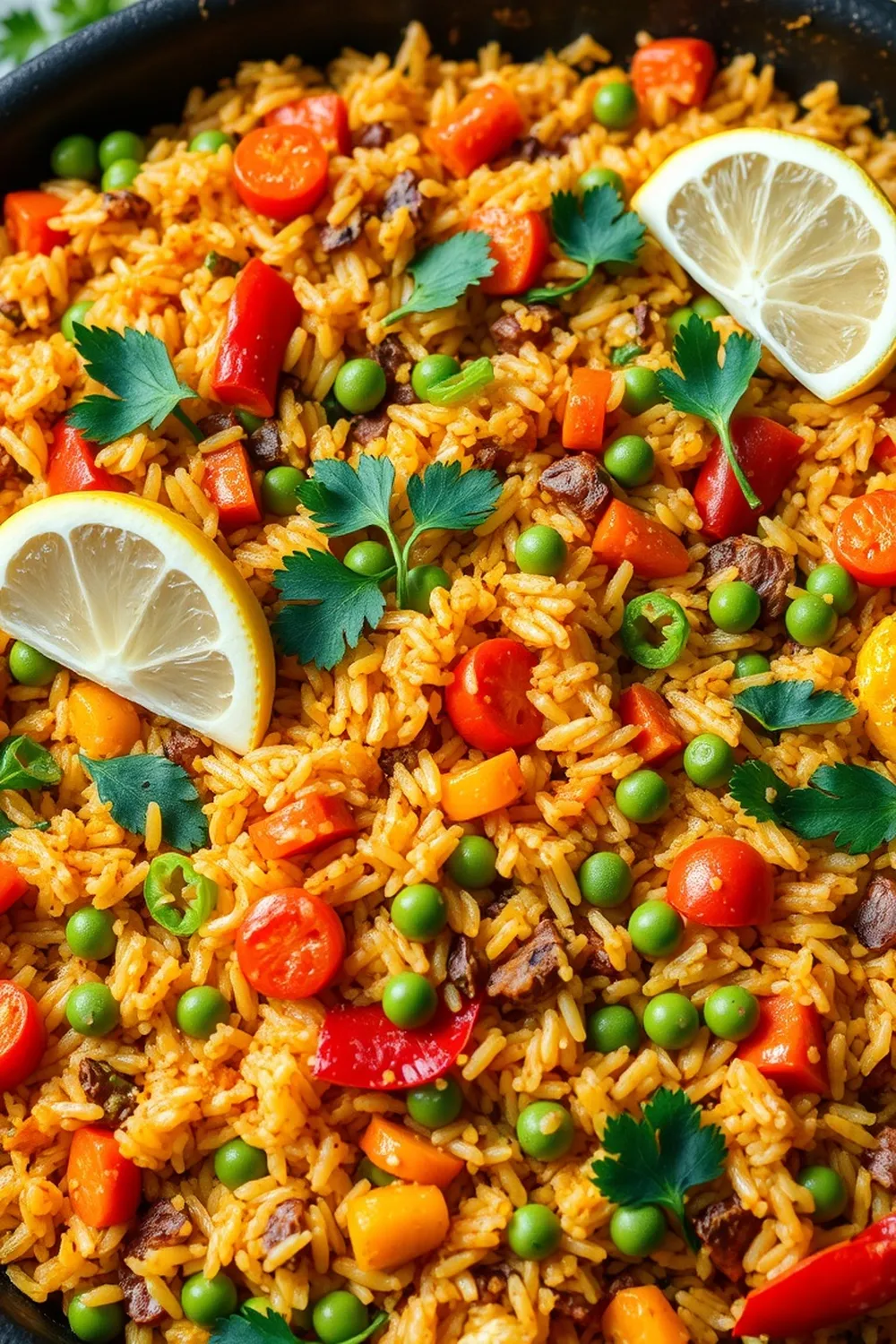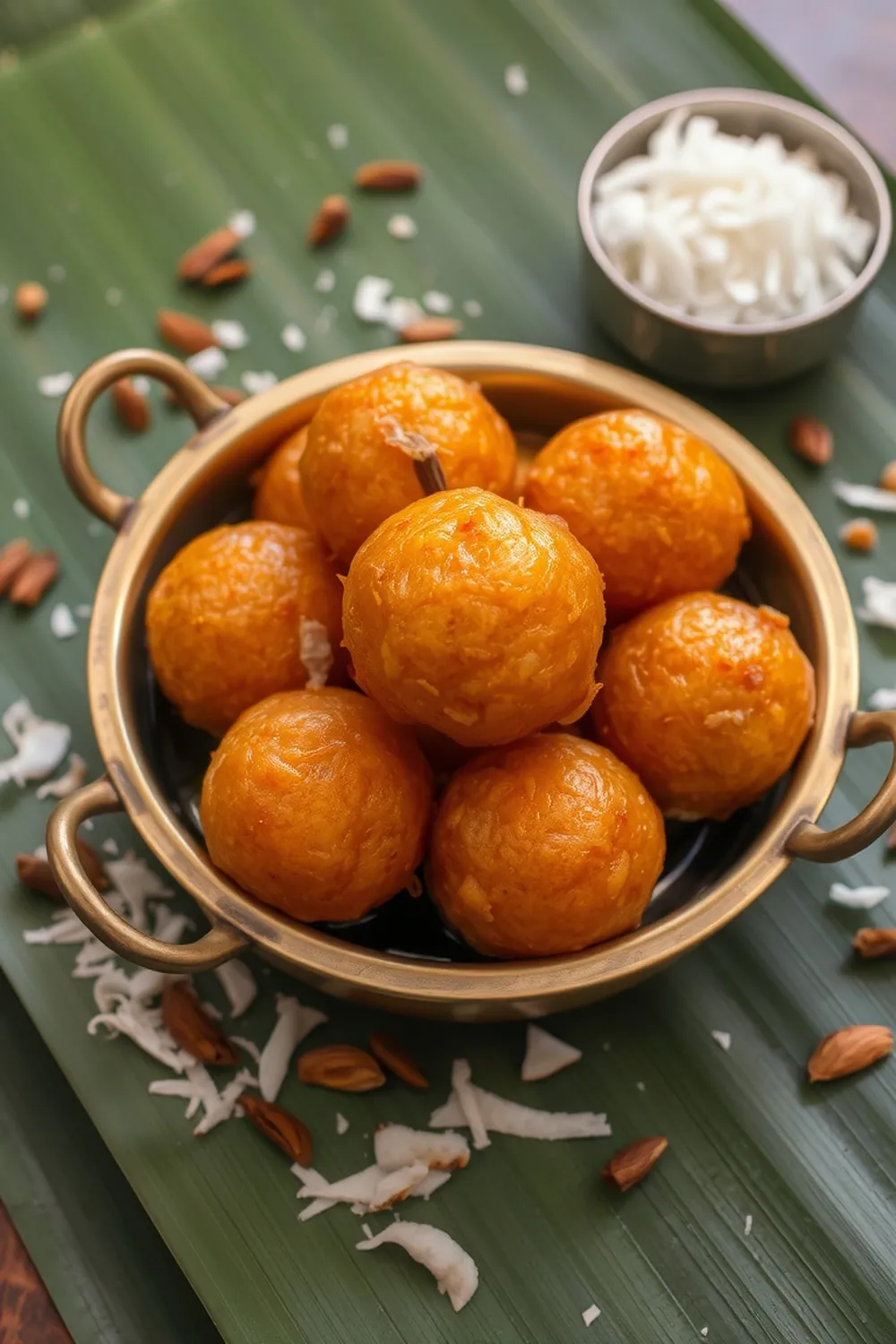- Rinse and soak basmati rice for 30 minutes. Parboil with whole spices until partially cooked, then drain.
- Prepare saffron-infused milk with rose/kewra water. Whisk yogurt until smooth.
- Sauté onions in ghee until golden, reserve half for layering. Add potatoes, carrots, peas, and cauliflower to remaining onions.
- Stir in ginger-garlic paste, biryani masala, and red chili powder. Mix in yogurt and water, then pressure cook vegetables for 2 whistles.
- Layer cooked rice and vegetable gravy in a pot, alternating with fried onions and saffron milk. Dot with ghee.
- Seal with foil and dum cook on low heat for 35 minutes or bake at 180°C until aromatic.
- Rest for 5-7 minutes before serving with raita or onion-lemon salad.
- Calories:380 kcal25%
- Energy:1589 kJ22%
- Protein:8 g28%
- Carbohydrates:60 mg40%
- Sugar:5 mg8%
- Salt:150 g25%
- Fat:12 g20%
Last Updated on 6 months ago by Neha Deshmukh
Vegetable Biryani Recipe – Saffron, Rose & Traditional Indian Flavors
Hey everyone! If you’re anything like me, the aroma of biryani instantly transports you to a happy place. It’s the celebratory dish in so many Indian households, and for good reason. Today, I’m sharing my go-to Vegetable Biryani recipe – packed with flavour, beautifully fragrant, and surprisingly achievable at home. I first made this for a family gathering and it was a huge hit, so I knew I had to share it with all of you!
Why You’ll Love This Recipe
This Vegetable Biryani isn’t just a meal; it’s an experience. It’s a beautiful blend of aromatic rice, tender vegetables, and a symphony of spices. The saffron and rose water add a touch of luxury, while the ‘dum’ cooking method ensures every grain is infused with flavour. Plus, it’s a fantastic way to get your veggies in!
Ingredients
Here’s what you’ll need to create this masterpiece:
- 1.5 cups basmati rice
- 5 cups water
- 2 green cardamom
- 1 cinnamon stick (1 inch)
- 2-3 cloves
- 0.5 teaspoon caraway seeds (shahi jeera)
- 0.5 teaspoon ghee
- 3 tablespoons ghee (for cooking)
- 1 Indian bay leaf (tej patta)
- 1 cup onion (thinly sliced)
- 1.75 cups potatoes (chopped)
- 0.5 cup carrots (chopped)
- 0.5 cup green peas
- 1.5 cups cauliflower florets
- 2 teaspoons ginger-garlic paste
- 0.5 teaspoon red chili powder
- 2 teaspoons biryani masala
- 0.5 cup yogurt (curd)
- 10-12 saffron strands
- 1 teaspoon rose water
- 1 teaspoon kewra water
Ingredient Notes
Let’s talk ingredients! Getting these right makes all the difference.
Basmati Rice: Choosing the Right Grain
Basmati is key for that fluffy, separate-grain texture. Look for aged basmati – it’s longer, more fragrant, and cooks up beautifully. I usually get the Daawat or India Gate brands.
Whole Spices: The Aromatic Foundation
Don’t skimp on the whole spices! They release incredible flavour as they bloom in the ghee. Lightly crushing them before adding them helps release even more aroma.
Ghee: Traditional Fat vs. Alternatives
Ghee is traditional and adds a unique richness. But if you prefer, you can use vegetable oil or a mix of oil and butter. Just remember ghee has a higher smoke point.
Shahi Jeera (Caraway Seeds): A Unique Flavor Profile
Shahi jeera has a slightly earthy, almost cumin-like flavour. It’s different from regular jeera (cumin seeds) and adds a lovely depth. If you can’t find it, you can use regular cumin, but shahi jeera is worth seeking out!
Rose & Kewra Water: Regional Variations & Substitutions
These floral waters are signature biryani scents. They’re often used in Awadhi biryani. If you can’t find them, a tiny drop of rose extract or a splash of orange blossom water can work in a pinch, but use sparingly – they’re potent!
Step-By-Step Instructions
Alright, let’s get cooking!
- First, rinse the basmati rice under cold water until the water runs clear. Soak it in water for about 30 minutes. This helps the grains cook evenly and become fluffy.
- In a large pot, bring 5 cups of water to a boil. Add the cardamom, cinnamon stick, cloves, shahi jeera, and a pinch of salt. Add the drained rice and parboil for about 7-8 minutes, until it’s about 70% cooked. Drain the rice and set aside.
- While the rice is soaking and parboiling, let’s work on the vegetable gravy. Heat 3 tablespoons of ghee in a heavy-bottomed pot. Add the sliced onions and sauté until golden brown and crispy. Remove half of the fried onions and set aside for layering later.
- Add the potatoes, carrots, peas, and cauliflower to the remaining onions. Sauté for a few minutes.
- Stir in the ginger-garlic paste, red chili powder, and biryani masala. Cook for another minute until fragrant.
- Add the yogurt and about 1 cup of water. Mix well and bring to a boil. Then, pressure cook the vegetables for 2 whistles. (If you don’t have a pressure cooker, you can simmer them covered until tender, about 20-25 minutes).
- While the vegetables are cooking, prepare the saffron milk. Warm about ¼ cup of milk and add the saffron strands. Let it steep for at least 15 minutes. Add the rose water and kewra water to the saffron milk.
- Now for the layering! In a heavy-bottomed pot (the same one you used for the gravy is perfect), start with a layer of the parboiled rice. Then, add a layer of the vegetable gravy. Sprinkle with some of the fried onions and drizzle with a little saffron milk. Repeat these layers, ending with a layer of rice.
- Dot the top with a little ghee.
- Seal the pot tightly with foil, then cover with a lid. This is crucial for trapping the steam and creating that ‘dum’ effect.
- Dum cook on low heat for 35 minutes, or bake in a preheated oven at 180°C (350°F) for about 40-45 minutes. You’ll know it’s ready when the aroma is intoxicating!
- Let the biryani rest for 5-7 minutes before fluffing it gently with a fork and serving.
Expert Tips
Achieving the Perfect Rice Texture
Don’t overcook the rice during the parboiling stage! It should be about 70% done.
Layering Techniques for Optimal Flavor
Layering is key! It ensures the rice and gravy infuse each other beautifully. Don’t be shy with the fried onions and saffron milk.
Dum Cooking: Mastering the Art of Slow Cooking
Dum cooking is all about slow, gentle cooking in a sealed pot. This allows the flavours to meld and the rice to become incredibly tender.
Variations
Vegan Vegetable Biryani
Simply substitute the ghee with vegetable oil and omit the yogurt, or use a plant-based yogurt alternative.
Gluten-Free Vegetable Biryani
This recipe is naturally gluten-free! Just double-check your biryani masala to ensure it doesn’t contain any gluten-based ingredients.
Spice Level Adjustments (Mild, Medium, Spicy)
Adjust the amount of red chili powder to your liking. For a milder biryani, use ¼ teaspoon. For a spicier kick, add up to 1 teaspoon.
Festival Adaptations (Eid, Diwali)
Biryani is a staple for festivals! You can add dried fruits like cashews and raisins for a richer, more festive touch.
Serving Suggestions
Raita Pairings
Biryani and raita are a match made in heaven! Cucumber raita, boondi raita, or even a simple yogurt raita are all fantastic choices.
Salad Accompaniments (Onion-Lemon)
A refreshing onion-lemon salad cuts through the richness of the biryani beautifully.
Other Side Dish Ideas
Mirchi ka Salan (chili curry) and Baingan Bharta (smoked eggplant mash) are also popular accompaniments.
Storage Instructions
Leftover biryani can be stored in an airtight container in the refrigerator for up to 3 days.
Reheating Tips
Reheat gently in a microwave or on the stovetop. Add a splash of water to prevent it from drying out.
Freezing Instructions
Biryani freezes well! Let it cool completely before transferring it to a freezer-safe container. It can be frozen for up to 2 months. Thaw overnight in the refrigerator before reheating.
FAQs
What type of rice is best for biryani?
Basmati rice is the gold standard for biryani. Its long grains and fragrant aroma make it perfect for this dish.
Can I use a different oil instead of ghee?
Yes, you can use vegetable oil or a mix of oil and butter. However, ghee adds a unique flavour and richness.
What is dum cooking and why is it important?
Dum cooking is a slow cooking technique where the food is cooked in a sealed pot, trapping the steam and allowing the flavours to meld. It’s essential for achieving tender, flavourful biryani.
How can I adjust the spice level of this biryani?
Adjust the amount of red chili powder to your liking.
Can I make this biryani ahead of time?
You can prepare the vegetable gravy and parboil the rice ahead of time. Assemble and dum cook the biryani just before serving.
What is the purpose of saffron milk in biryani?
Saffron milk adds a beautiful colour, aroma, and subtle flavour to the biryani. It’s a signature ingredient in many biryani recipes.
Enjoy! I hope this Vegetable Biryani becomes a favourite in your home too. Let me know how it turns out in the comments below!










